CHAPTER III. EAFM Indicator Scoring Technique In the Economic Domain
3.1. Data collection technique
In assessing EAFM indicators in the economic domain, primary data was obtained through direct field observations, and secondary data were obtained from available references. Interviews were conducted after determining the selected respondents from the sampling results. It was carried out by face-to-face debriefing using a guide or questionnaire to obtain information according to the purpose of this study. The characteristics of direct interviews are as follows.
-
The interviewer and the respondent do not know each other;
-
The interviewer asked the respondent to answer the following;
-
The interviewer is neutral, does not direct the respondent; and
-
The questions asked to follow the guide or questionnaire.
Sampling was done using the stratified random sampling method, in which the interview respondents were determined in stages. This sampling technique pays attention to each population element from each group that does not overlap (homogeneous elements) and must have the same opportunity to be selected. Strata sampling can use administrative limits, experience levels, and fishermen's productivity. The allocation of the number of samples from each level is sought using the principle of proportional allocation.
Description of data collection techniques for each indicator is described as follows:
a. Asset ownership
Asset ownership indicator data/information can be obtained through:
-
Direct observation of inland fishing villages to identify the number, type, and value of assets owned by a fishing household, both household assets, fishery production assets, and other assets.
-
Report on the results of monitoring/supervision of capture fisheries from the relevant work unit.
-
Reports on the results of research/study from related research institutions, Higher Education institutions, or academics; and or
-
Results of interviews with other competent respondents.
The steps for assigning a criterion value to the asset ownership indicator are as follows:
-
Collecting data on the total number, type, and value of assets owned by one fishery household in an inland water ecosystem (Σ assets);
-
Identification of the number, type, and value of assets owned by a Fishery Household obtained from the results of fishing business activities in an inland water ecosystem (asset b);
-
Calculate the percentage of the value of asset b compared to the total value of Σ assets; And
-
Give the value of the criteria (nk) indicator of asset ownership with the following value criteria:
-
nk = 1, if the amount/value of asset b does not increase
-
nk = 2, if the amount/value of assets b <30%
-
nk = 3, if the amount/value of asset b > 30%
Some of the stakeholders who can be used as respondents in assessing the indicators of Asset Ownership include::
-
Public figure;
-
fishery extension; and/or
-
Fisherman
b. Revenue Proportion
Income Proportion indicator data can be obtained through the following:
-
Direct observation of inland fishing villages to identify the income earned in one fishery household from capture fisheries activities in an inland waters ecosystem.
-
Report on the results of monitoring/supervision of capture fisheries from the relevant work unit.
-
Reports on the results of research/study from related research institutions, Higher Education institutions, or academics; and/or.
-
Results of interviews with other competent respondents.
The steps for giving criterion values to the Fisheries Household Income indicator are:
-
Find out the amount of the Regional Minimum Wage (UMR) in the Regency/City that is the survey location;
-
Identify the amount of monthly income earned in one Fishery Household from capture activities in some inland water ecosystems; and
-
Give the criterion value (nk) of the Fisheries Household Income indicator with the following value criteria:
-
nk = 1, if the proportion of income from capture fisheries is low (<50% UMR)
-
nk = 2, if the Proportion of Income from Capture Fisheries is moderate (50-75% UMR)
-
nk = 3, if the Proportion of Income from Capture Fisheries is high (>75% UMR)
Some of the stakeholders who can be used as respondents in assessing the indicators of Asset Ownership include::
-
Public figure;
-
fishery extension; and/or
-
Fisherman.
c. Fishermen Expenditure Proportion
Fishermen Expenditure Proportion indicator data can be obtained through the:
-
Direct observation of inland fishing villages to identify the proportion of fishermen's expenditure each month.
-
Report on the results of monitoring/supervision of capture fisheries from the relevant work unit.
-
Reports on the results of research/study from related research institutions, Higher Education institutions, or academics; and/or
-
Results of interviews with other competent respondents.
The steps for assigning a criterion value to the Fishermen Expenditure Proportion indicator, namely:
-
Recording the total expenditure of fishermen in one fishery household every month;
-
Identify the total expenditure of fishermen in one fishery household every month that is used to buy food needs; And
-
Give the value of the criteria (nk) indicator of asset ownership with the following value criteria:
-
nk = 1, if expenditure for non-food < expenditure for food
-
nk = 2, if non-food expenditure = expenditure for food
-
nk = 3, if expenditure for non-food > expenditure for food
Some of the stakeholders who can be used as respondents in evaluating the Proportion of Fishermen Expenditures indicator include::
-
Public figure;
-
fishery extension; and/or
-
Fisherman.
d. Economic Dependency Indicator
Economic Dependency indicator data can be obtained through the following:
-
Direct observation of inland water fisherman households to identify sources of income for fishing households.
-
Report on the results of monitoring/supervision of capture fisheries from the relevant work unit.
-
Reports on the results of research/study from related research institutions, Higher Education institutions, or academics; and/or
-
Results of interviews with other competent respondents.
The steps for assigning a criterion value to the Fishermen's Source of Income indicator are:
-
Identification of fishery household income stream; and
-
Give the criterion value (nk) of the fishery household source of income indicator with the following value criteria:
-
nk = 1, if the family economy derived from the capture fisheries business is only an additional sideline
-
nk = 2, if the family's economy comes from the capture fisheries business in the form of the main sideline
-
nk = 3, if the family's economy only comes from fishing activities
Some of the stakeholders who can be used as respondents in evaluating indicators of fishermen's sources of income include::
-
Public figure;
-
fishery extension; and/or
-
Fisherman.
3.2. Analysis Techniques
EAFM analysis is a multi-attribute approach to symptoms or indications of aquatic ecosystem conditions. Substantially, the assessment of EAFM indicators is a multi-criteria analysis system that ends in assessing a composite index to determine the status of fisheries management using the Flag Modeling technique (Adrianto, Matsuda, and Sakuma, 2005). Data analysis is needed to find out the relationship between the current status of management performance based on the data of each indicator in the Economic domain and recommendations for fisheries management actions that will be developed.
Tools available can be used to analyze the condition of EAFM in general and the conditions of each EAFM domain, especially the Economic domain, using the EAFM indicator assessment matrix (as attached). In detail, the method of calculating the composite value on economic indicators and domains is described as follows:
a. Asset ownership
The formula used to calculate the composite indicator value (CI) of asset ownership is:
Description:
Meanwhile, the formula used to calculate the weight value (br) of asset ownership is:
b. Revenue Proportion
The formula used to calculate the composite value of the income proportion indicator (CI) is:
Description:
Meanwhile, the formula used to calculate the weight value (br) of the Income Proportion indicator is:
c. Expenditure Proportion
The formula used to calculate the composite indicator value (CI) of the Expenditure Proportion is:
d. Economic Dependency Indicator
The formula used to calculate the composite indicator (CI) value for Economic Dependence is:
e. Livelihood Performance Indicator
The formula used to calculate the composite indicator (CI) value of Livelihood Performance is:
Meanwhile, the ranking value (nr) of indicators in the Economic domain has been agreed upon for each WPPNRI-PD, namely:
The Domain Composite Value (CD) for the Economic domain can be calculated by adding up all the CI values obtained according to the following formula:
The value obtained is used to analyze the flag status condition of the Economic domain within the framework of implementing fisheries management with an ecosystem approach or the Ecosystem Approach to Fisheries Management (EAFM) in Inland Waters. The status flag criteria for the Economic domain are grouped based on 3 (three) categories, namely:
value obtained is used to analyze the flag status condition of the Economic domain within the framework of implementing fisheries management with an ecosystem approach or the Ecosystem Approach to Fisheries Management (EAFM) in Inland Waters. The status flag criteria for the Economic domain are grouped based on 3 (three) categories, namely:
To conclude the status flags of EAFM in an inland water fisheries management unit, it is agreed upon a domain ranking weight (brd) to measure the interaction or influence of each domain, namely:
The value of the effect of the Economic domain on the entire EAFM domain can be determined by multiplying
can be determined by multiplying  by the ranking weight for the economic domain
by the ranking weight for the economic domain  according to the following formula:
according to the following formula:
EAFM Status flags can be known by calculating the aggregate of all CDI values according to the following formula:
The flag status criteria for fisheries management conditions in an inland waters ecosystem are grouped into 3 (three) categories, namely:
In brief, the assessment of the EAFM indicators for the case study in WPPNRI-PD 435, which is used in the process of input and analysis of Economic Domain data, can be illustrated as follows:
Table3. Economic Domain data input and analysis process
Source: Technical Instructions for Assessment of Inland EAFM in Indonesia, 2020
Notes: 2 (two) factors determine its value, namely weight, and score, to evaluate each indicator in each domain. The weight is from a set of indicators in the same domain, ordered by level of importance from high to low, with a total of 100% (maximum 1). The score uses a Likert scale of 1 to 3, namely 1 = low, 2 = moderate, and 3 = high
Based on the calculation of the CD2 value above, it is known that the Economic Domain status flag is green or in GOOD condition. It shows that the condition of the local economic domain has implemented the principles of sustainable fisheries but is not yet optimal, so it is necessary to establish a strategic plan to maintain or improve the existing domain conditions and indicators.







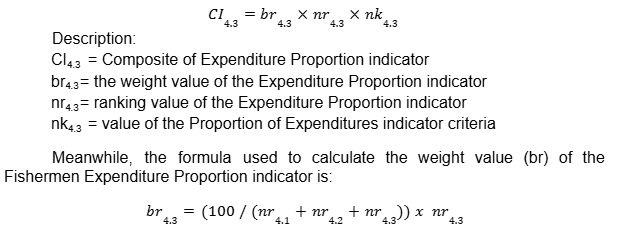
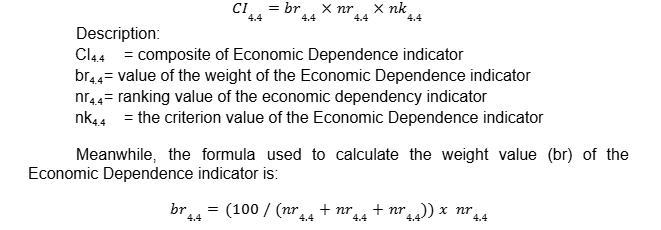
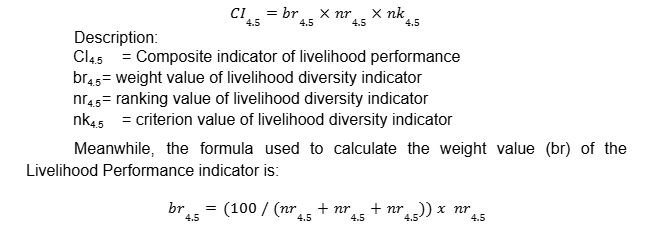





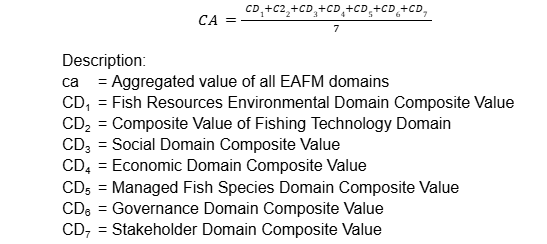
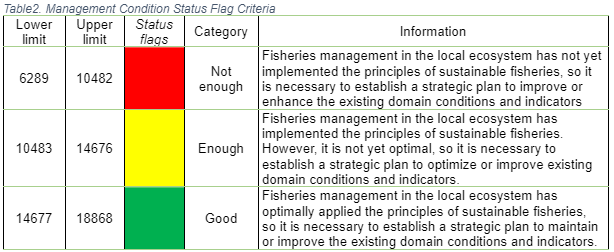
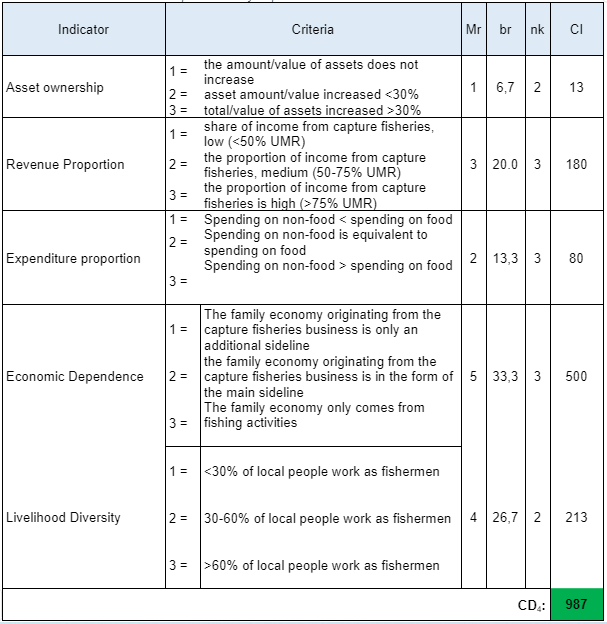
No Comments